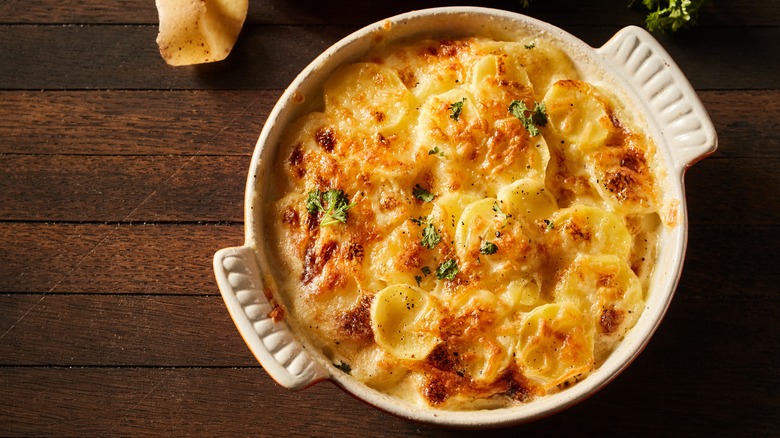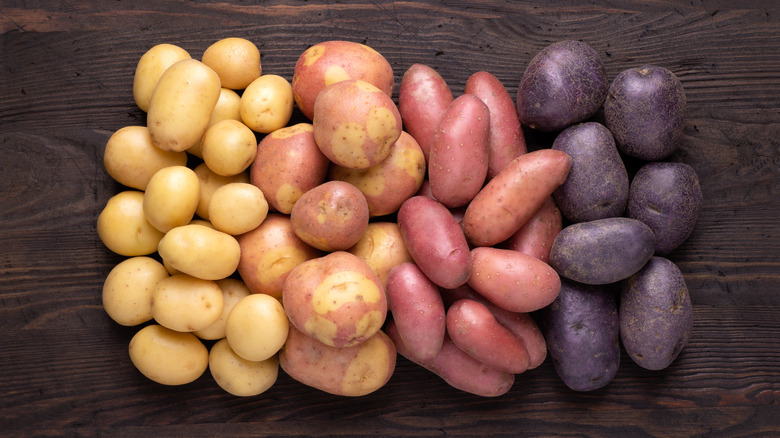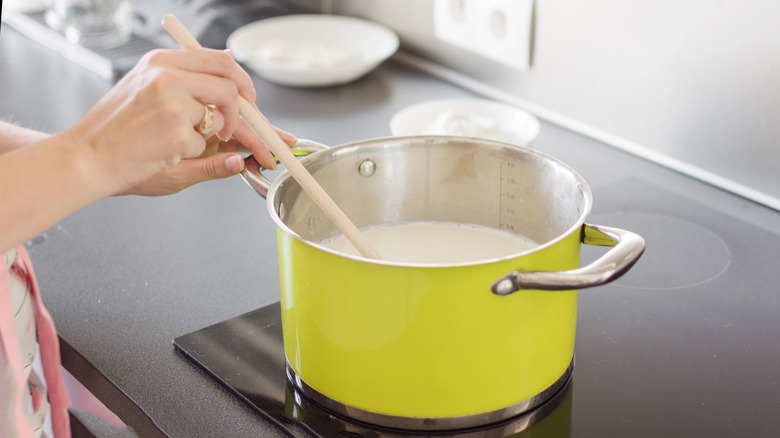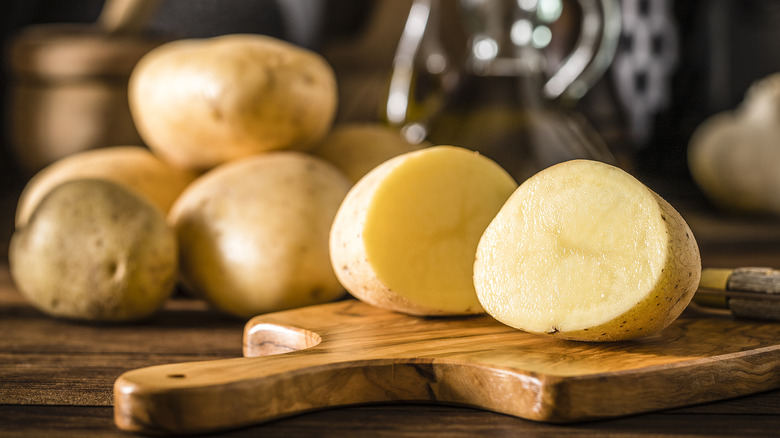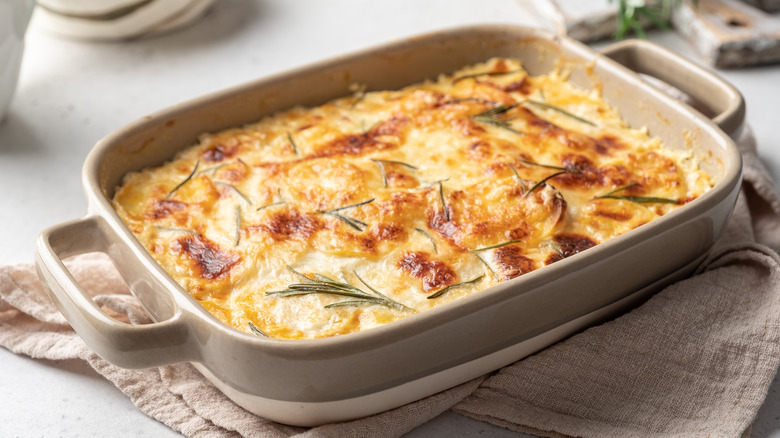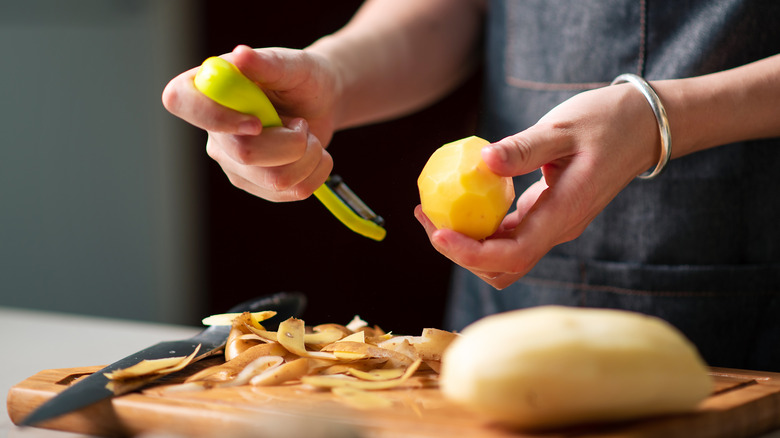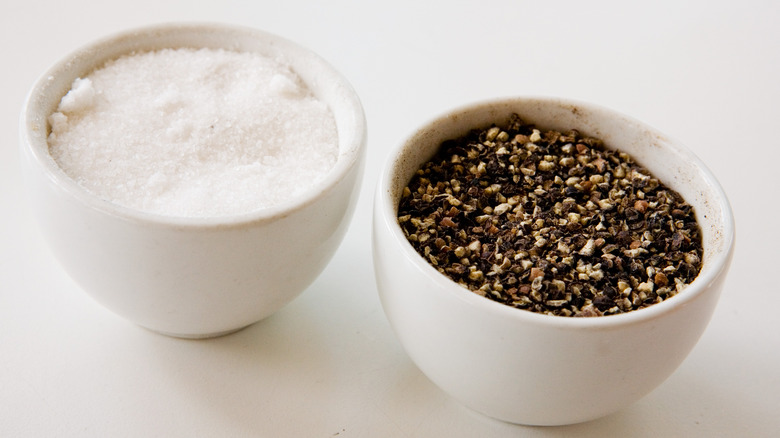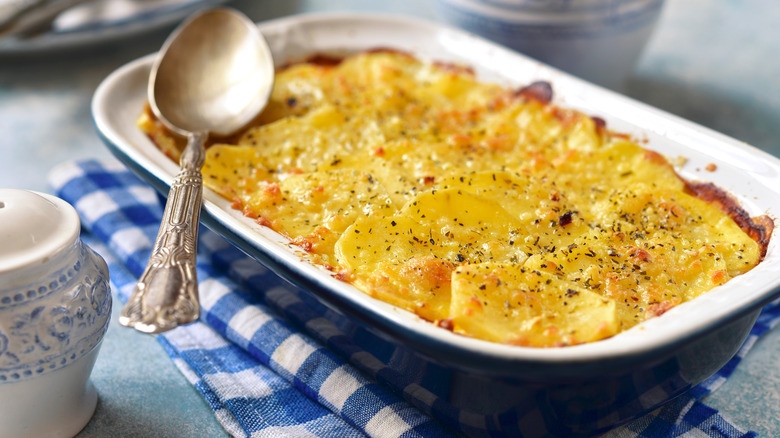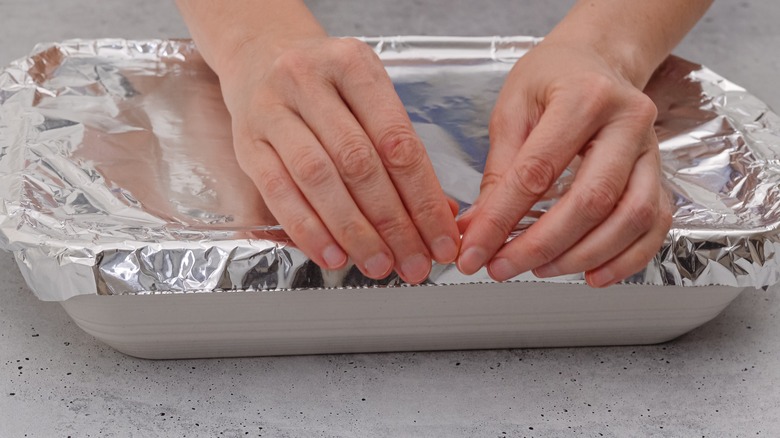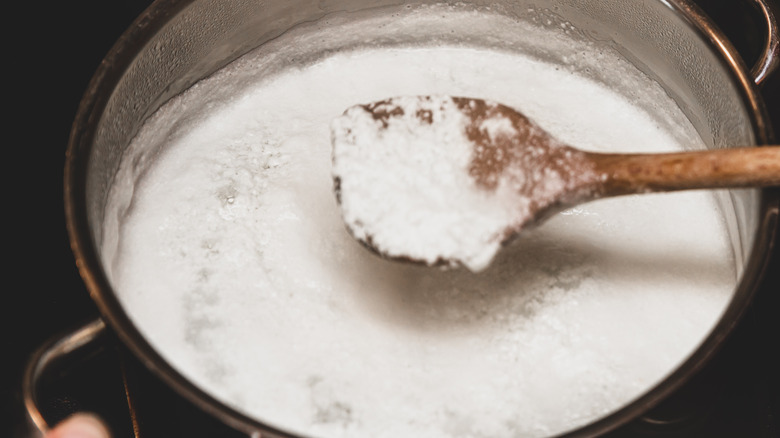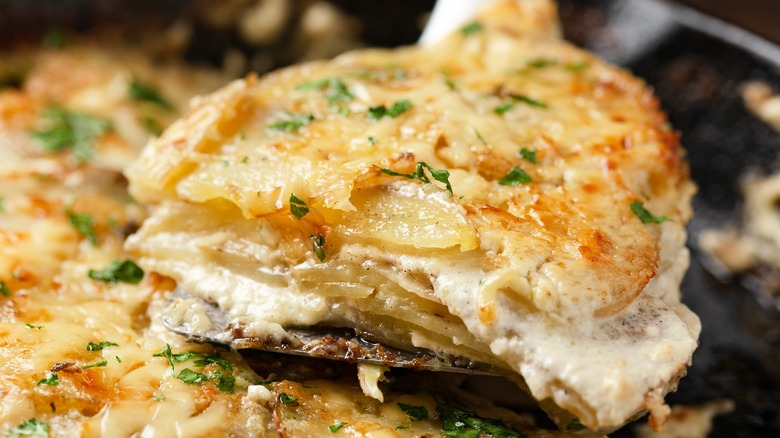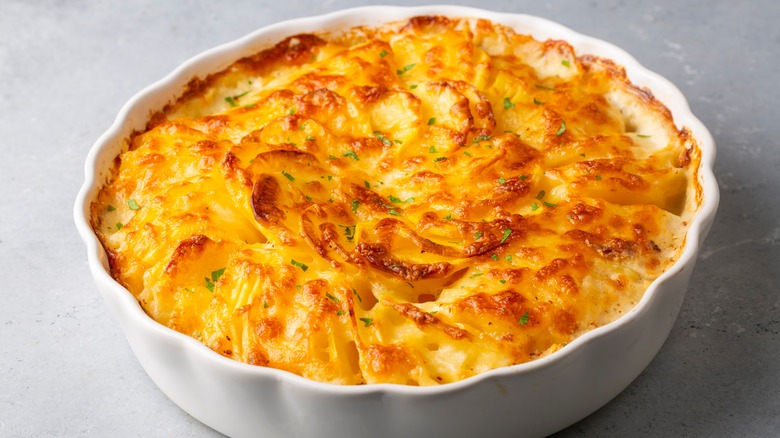Mistakes Everyone Makes When Cooking Scalloped Potatoes
We all know how delicious scalloped potatoes are when they're done right. But we've also probably made some scalloped potatoes that fell flat and weren't as good as they should have been. Many home cooks, whether seasoned or new to the kitchen, inadvertently make common mistakes that can turn this tasty dish into a disappointment. In this article, we'll dissect these missteps and guide you through the nuances of making the best potatoes of your life.
One prevalent error lies in the thickness of the potato slices. Too thin, and they risk turning mushy during baking; too thick, and achieving that perfect tender bite becomes a challenge. Finding the Goldilocks zone for your potato slices is the first step towards scalloped potato success. Then, there are other common problems, like using low-fat dairy and using the wrong variety of potatoes. Any one of these can lead to subpar results.
This article is your culinary compass, steering you away from these common pitfalls and toward a batch of scalloped potatoes that will have your guests coming back for seconds. Learn the ropes, avoid the pitfalls, and savor the satisfaction of a flawlessly executed dish.
Using the wrong type of potatoes
The choice of potatoes significantly influences the texture and appearance of scalloped potatoes. Starchy, floury varieties like russets or Yukon Golds play a crucial role in achieving the thick, velvety sauce and the distinctive layered structure that defines this classic dish.
Russet potatoes, in particular, are known for their high starch content, making them ideal for creating a creamy sauce. When cooked, russets break down more easily, contributing to a smooth and luscious texture that envelops the potato slices. This attribute is what gives scalloped potatoes their signature rich and indulgent flavor.
On the other hand, Yukon Golds, while also starchy, boast a slightly firmer texture compared to russets. This quality allows them to hold their shape a bit better during the baking process. The result is a more defined and structured layering of potatoes, maintaining a balance between creaminess and distinct slices.
Ultimately, whether you choose russets or Yukon Golds depends on your preference for the texture of the final dish. If you lean towards an exceptionally creamy and melt-in-your-mouth experience, opt for russets. If you prefer a bit more texture and distinct layers, Yukon Golds are an excellent choice. And, of course, you can also experiment with other floury varieties of potatoes. Any of these will lead you to a delicious batch of scalloped potatoes.
Not infusing the cream with aromatics
When you're aiming for exceptional scalloped potatoes, some recipes may advise sautéing onions, garlic, and ground spices to enhance the sauce's flavor. However, this approach introduces small, distinct bits to the sauce, potentially compromising its luxurious, smooth texture. To achieve the pinnacle of scalloped potatoes, a more effective method involves infusing the desired flavors directly into the cream (or a mixture of milk and cream, depending on the recipe).
The process is surprisingly straightforward. Combine the dairy mixture with aromatics like shallots (chopped in half), garlic (smashed cloves), and whole peppercorns in a small pot. Bring this mixture to a simmer, then turn off the heat, cover the pan, and allow it to sit for 30 minutes. This lets the aromatics impart their essence into the liquid without introducing undesirable bits to the final dish. After the infusion period, strain out the aromatics, leaving behind a subtly flavored cream-milk mixture ready to elevate the overall taste of your scalloped potatoes.
By adopting this method, you'll ensure that the flavors are seamlessly integrated into the sauce, contributing to a more refined, velvety texture in your scalloped potatoes. Rather than making the mistake of using chopped onions and garlic, this alternative gives you great flavor without unwanted chunks.
Cutting potatoes too thinly or too thickly
When slicing potatoes for scalloped potatoes, getting the thickness just right is crucial. If the potato slices are too thin, they can become mushy and disintegrate during the baking process. This can result in a less appealing texture and a lack of distinct layers in the final dish. Thin slices might also absorb too much of the creamy sauce, potentially leading to a soggy consistency.
On the other hand, if the potato slices are too thick, they may not cook through properly during the baking time. Thick slices can remain firm and undercooked, resulting in an uneven texture in the dish. The goal with scalloped potatoes is to achieve a perfect balance between tenderness and structure, and overly thick slices can disrupt this balance.
To achieve the perfect texture, the potato slices should ideally be between ⅛- and ¼-inch thick, and it's essential to maintain uniform thickness throughout. Using a mandoline or a vegetable slicer can make this task swift and precise. These tools help ensure that each potato slice is consistent in thickness, promoting even cooking and a uniform texture in the final dish. If you don't have a mandoline, a sharp chef's knife can also do the job, although it requires a bit more care, precision, and attention to detail.
Rinsing the potatoes before cooking them
Rinsing sliced potatoes before layering them in a scalloped potato dish is a common mistake that can impact the final texture and structure of the dish. The natural starch present in potatoes plays a crucial role in enhancing both the sauce and the overall form of scalloped potatoes.
When potatoes are sliced, they release starch. This starch is beneficial because it contributes to thickening the creamy sauce as the dish bakes. The starch absorbs some of the liquid, creating a velvety and rich consistency that defines the classic scalloped potato experience. Additionally, the starch helps bind the layers together, providing the dish with a cohesive structure.
Rinsing the sliced potatoes removes this valuable starch, diminishing the thickening effect and potentially resulting in a less creamy sauce and a looser, less cohesive dish. To preserve the desired texture and structure of scalloped potatoes, it's advisable to embrace the natural starch by skipping the rinsing step. This allows the starch to work its magic during the baking process, ensuring a satisfyingly thick and well-structured dish.
Letting potatoes oxidize
Slicing potatoes for scalloped potatoes ahead of time might seem like a time-saving strategy, but it can lead to an undesirable outcome. When they're exposed to air, sliced potatoes are prone to developing a purple or gray tinge, indicating oxidation. This discoloration is a sign that the potatoes have been sitting out for too long.
To avoid this issue, you should slice the potatoes just before you need them. This ensures that the potatoes retain their natural color and freshness. If potatoes are sliced too early, the oxidized color may affect the overall aesthetics of the scalloped potatoes. However, it's worth noting that oxidized potatoes are still safe to eat and have the same taste and texture.
While some suggest placing sliced potatoes in water to prevent oxidation, this approach has its drawbacks. Water can lead to the removal of starch from the potatoes, potentially affecting the thickening properties of the sauce during baking. To preserve the integrity of the dish, it's better to slice the potatoes right before assembling the scalloped potatoes. This way, you maintain the color of the potatoes and ensure that their natural starch is retained.
Using low-fat dairy
Scalloped potatoes are meant to be rich and delicious. This absolutely isn't the place for low-fat dairy. It can compromise both the texture and richness of the dish. There are two main reasons for avoiding low-fat dairy in this context. First, the sauce in scalloped potatoes has a higher risk of splitting when made with low-fat dairy. The reduced fat content can make the sauce less stable, leading to separation during the baking process. This can result in a less cohesive and visually appealing dish.
Secondly, using low-fat dairy can diminish the overall creaminess of scalloped potatoes. The richness and velvety texture that characterize this classic dish are achieved through the fats present in ingredients like whole milk or heavy cream. Opting for low-fat alternatives might leave the dish with a thinner and less indulgent consistency.
Some recipes call for whole milk or a mixture of cream and milk. For those seeking an even more decadent experience, substituting heavy cream for any whole milk in the recipe can elevate the richness of the scalloped potatoes. Heavy cream adds a luxurious, silky quality to the sauce and makes it taste even better. In a dish like this that's supposed to be creamy and decadent, you have to embrace full-fat dairy.
Not seasoning every layer
One of the most common errors that leads to lackluster scalloped potatoes is underseasoning. Potatoes, while excellent at absorbing flavors, don't boast a robust taste on their own. To elevate their deliciousness, it is essential to season them thoroughly. A well-seasoned sauce is the backbone of flavorful scalloped potatoes, but don't stop there — each layer of potatoes deserves attention.
Seasoning each layer with salt and pepper while assembling the dish ensures that each bite is as tasty as you want it to be. This step adds depth and complexity to the dish, allowing the potatoes to absorb all that delicious seasoning, so they're flavorful and not bland. By seasoning at both the sauce and individual layer levels, you guarantee every mouthful of your dish tastes as good as the last.
So when you're crafting this classic dish, be generous with your seasonings. Both salt and pepper play their part in this dish. You can even experiment with white pepper or mixed peppercorns if you want to mix things up a bit without going wild with unexpected flavors. Keep your seasonings classic, but make sure you don't underdo it. Look to a trusted recipe to find the right ratio of salt and pepper to sauce and potatoes.
Using a baking dish that's too deep
The choice of a baking dish plays a crucial role in the outcome of scalloped potatoes. If the dish is too deep and you need to stack your potatoes high, it can lead to uneven cooking, presenting a range of issues. The top layer may become overly browned or even risk burning in the oven, while the center of the dish may be undercooked. This kind of uneven cooking is always a disappointment and can throw you off your potato game.
To achieve consistent and perfectly cooked scalloped potatoes, it's advisable to opt for a larger and shallower baking dish. This design promotes even heat distribution, ensuring that each layer of potatoes cooks uniformly. The shallower depth allows for better control over the browning process, preventing the top layer from getting too dark before the center has a chance to reach the desired level of doneness.
If you're not sure what size of baking dish to use, it's a good idea to check your recipe. The recipe's guidelines can provide valuable insights into the ideal dimensions, helping you avoid potential pitfalls and achieve a well-balanced, perfectly cooked batch of scalloped potatoes. Choosing the right baking dish is a simple yet critical aspect of ensuring the success of this classic comfort dish.
Not covering the dish with foil for part of the cooking time
Covering the dish with foil is a key step in the process of making perfect scalloped potatoes, and it serves a crucial purpose. Without this cover, the dish can encounter a common dilemma — appearing done on the surface while still raw in the middle. So you may serve up your potatoes only to find they're undercooked inside. Alternatively, if you cook the dish uncovered for the full designated cooking time, you risk a burnt top by the time the center cooks through.
The recommended method involves initially cooking the dish with foil covering it for the first 30 minutes of the total cooking time. This protective layer ensures that the heat is evenly distributed, allowing the potatoes in the middle to cook through without the top layer becoming overly browned or burnt. After the initial 30 minutes, removing the foil and continuing to cook uncovered for another 20 to 30 minutes adds the finishing touch. This step allows the top layer to develop a desirable golden brown crust without compromising the even bake of the entire dish.
Using foil ensures a beautifully browned top to your scalloped potatoes, rather than a burnt one. While also making sure that the entire batch of scalloped potatoes cooks to perfection and isn't crunchy and raw in the center.
Curdling the dairy
It's hugely disappointing to get your potatoes out of the oven, only to realize the creamy sauce has curdled. Several factors can contribute to this undesirable outcome. One common cause is excessive heat, where high temperatures prompt milk proteins to bind together, forming lumps. To prevent curdling, you should cook scalloped potatoes at a relatively low heat — around 325 degrees Fahrenheit is ideal.
When incorporating ingredients like onions or garlic, a preemptive step can be taken to reduce the risk of curdling. Cooking these ingredients before adding them to the dish helps release some of their acidity, which, when combined with milk, could otherwise contribute to curdling. Alternatively, follow our advice to use an infused cream instead of whole chunks of onions.
The choice of dairy is also a key consideration. As previously mentioned, opting for whole milk or heavy cream is advised, as a higher fat content reduces the likelihood of curdling during cooking. You should also check that your dairy products are fresh. Older milk and cream are more prone to curdling. By paying attention to these details, you can ensure a velvety texture in your scalloped potatoes without unpleasant curdled dairy ruining the dish.
Overcooking
We all want the perfect scalloped potatoes, but overcooking them is a common mistake. If you want the perfect texture (which: of course you do), it's vital that you make sure you don't cook them for too long. Overcooking can lead to sub-par potatoes. You might end up with curdled dairy, for starters. Then, there's the chance of mushy potatoes, rather than soft ones that can still hold their structure and their layered form. The key is to cook the dish only until the potatoes reach a fork-tender state.
To prevent overcooking, it's a good idea to start checking for doneness every few minutes in the last five to 10 minutes before the specified cooking time mentioned in the recipe. This vigilant monitoring ensures that you catch the potatoes at the right moment, achieving that delicate balance where they are tender enough to yield to a fork but still maintain their structure, giving you the perfect taste and texture. By exercising this careful approach, you can enjoy scalloped potatoes with the ideal blend of creamy sauce and perfectly cooked, layered potatoes.
Not letting the finished dish rest
A common mistake when preparing scalloped potatoes is serving them immediately after you remove them from the oven. It's tempting to dive into the dish right away, but allowing these potatoes to cool and rest for 20 to 30 minutes will improve them immensely. It might seem like a long time to wait, but it is absolutely worth it.
Freshly baked scalloped potatoes are not only too hot to savor properly, but their true potential in terms of texture and flavor is best unlocked during the cooling period. As these potatoes settle, a positive transformation occurs. They firm up gradually, achieving a consistency that makes serving them a more refined and controlled affair. Rather than being left with wet, runny potatoes on your plate, these have a more cohesive texture.
The pursuit of perfect scalloped potatoes entails achieving a creamy texture without losing control over the moisture in the dish. In addition to letting them cool and rest, serving them at a warm rather than scalding temperature enhances the overall enjoyment of the dish. This temperature allows for a more nuanced appreciation of the flavors and the velvety texture that defines well-prepared scalloped potatoes.
In essence, exercising patience in the final stages of preparing scalloped potatoes reaps rewards on the dining table. The cooling and resting period isn't just a practical consideration to avoid burns; it's a culinary strategy to ensure that each bite of scalloped potatoes is the most delicious it can be.
